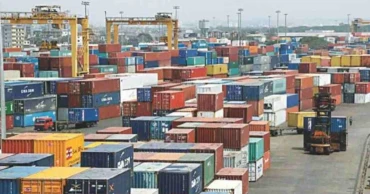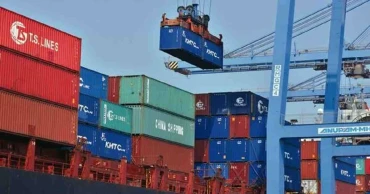export earnings
Bangladesh’s export earnings hit $8.69 billion in July-August
Bangladesh recorded export earnings of US$ 8.69 billion during the first two months (July–August) of the current fiscal year 2025–26, reflecting a 10.61 percent growth compared to the same period during the previous fiscal year.
Despite this overall positive performance, the year-on-year growth declined by 2.93 percent in August 2025. Export earnings for August 2025 stood at $3.92 billion, slightly lower than the $ 4.03 billion achieved in August 2024.
Expatriates sent $2.08 billion in remittances in 27 days of August
US tariffs disrupted global demand and supply chains, causing a fall in supply orders from international buyers. After a successful tariff negotiation with Washington, export orders surged in Bangladesh, businesses said.
The Export Promotion Bureau (EPB) noted that while export performance in the opening months of the fiscal year indicates resilience, the slowdown in August underlines the challenges facing Bangladesh’s export sector in the context of global demand fluctuations and evolving market dynamics.
Bangladesh Bank reconstitutes Premier Bank board over poor governance
4 months ago
Exports robust, August earnings rise to $4.78 billion
Bangladesh’s export earnings increased by 3.8 percent year-on-year to USD $4.78 billion in August, compared to the previous fiscal year (FY2022-23).
The Export Promotion Bureau (EPB) published this information on Monday (September 04, 2023), which shows that the garment sector is the major contributor to the overall export earnings.
The sector insider shows it as good news amidst falling inward remittances in August.
Also read: RMG exports for July-August this year grow by 12.46%
As a percentage, compared to 2022, export income increased by 3.8 percent in August 2023. However, the government's target was not met. The government's export revenue target for that month was over $4.87.
According to EPB data, 26 types of products including garments, medicine, and leather were exported to the world market in the month of August of the current financial year 2023-24. From there, $4.78 crore has been earned in August.
Also read: RMG exports: Bangladesh earned $3.95 billion in July, says BGMEA
During the same period of the financial year 2022-23, the export revenue was $4.6 billion. Accordingly, compared to last year, the income has increased by $17.51 crore, which has increased by 3.8 percent.
Also read: Bangladesh's RMG export to USA grows 6.31% in FY 2023-24
2 years ago
Jellyfish: Out of the fishing net and into the export basket?
Jellyfish has always been considered an inedible and therefore useless catch by the fishing communities in the country’s coastal districts. Despite never being considered as commercially viable, new research by Bangladeshi scientists indicates jellyfish can eventually become a source of export earnings.
Like elsewhere, the coast of Bangladesh too plays host to a large number of jellyfish. However, the researchers do not yet know how many jellyfish there are in the waters of Bangladesh. This amount will have to be verified in the research they have now started.
Made up of 90 percent water, jellyfish have no brain, blood, or bones.
Scientists say that the number of jellyfish depends largely on the salinity and temperature of the water. Due to the lack of rain this year, the salinity of the seawater was high, resulting in an abundance of jellyfish washing up on shore.
Read more: Scores of jellyfish carcasses wash ashore on Cox’s Bazar beach
Md. Rashed-Un-Nabi, Professor, Department of Fisheries, Chittagong University told UNB, "Many countries in the world are researching how to use jellyfish, we have also started research. It shows that it has a lot of economic potential.”
Scientists saw a boom or excess of jellyfish on Patuakhali beach and Cox's Bazar beach in August. At that time, many fishermen were forced to cut their nets because they were filled with jellyfish.
Golam Mostafa, associate professor of Noakhali Science and Technology University (NSTU) said, “We can divide the jellyfish found in the sea of Bangladesh into three categories.”
“One is edible jellyfish. We don't eat it here. But it is in demand as food in Taiwan, Vietnam, Thailand, and China. Each of these jellyfish can weigh up to 8 to 10 kg,” he said.
Read more: Hundreds of Jellyfish carcasses wash ashore on Cox’s Bazar beach
As a result, it is possible to export to the countries mentioned if extracted commercially, Mostafa said. This type of jellyfish can also be used as raw material for the pharmaceutical and cosmetics industry.
There is another type of jellyfish, which is poisonous. Physical contact with this type can damage a person’s nervous system and lead to paralysis. However it is only a very specific subtype of jellyfish that tends to be poisonous.
The Box Jellyfish, so-called for its box-like physique, is classified as one of the most venomous creatures on Earth, containing toxins that attack the heart, nervous system, and skin cells.
Golam Mostafa observes that fishermen need to be made aware of and trained on this type of jellyfish.
Read more: Hundreds of Jellyfish carcasses wash ashore on Cox’s Bazar beach
“The damage caused to fishermen is also an economic loss. Many times fishermen do not understand it properly,” he adds.
The third and final type of jellyfish found in Bangladesh is a very small creature. These are used in aquariums or as part of beautification in many countries, he said.
“You can call it recreational use. Many countries, including Thailand, have such aquariums, where palm-shaped transparent jellyfish are kept. The colour of the light you cast becomes that colour. It is a very attractive thing for tourists,'' Golam Mostafa said, an associate professor of NSTU.
He said that the researchers of oceanography and fisheries departments of some universities and the Bangladesh Oceanographic Research Institute (BORI) are researching the potential of jellyfish.
Read more: Fish scales: A promising new item to diversify exports
3 years ago
RMG exports rise in Oct despite overall decline
The Export Promotion Bureau (EPB) data show that, despite an overall drop in export earnings, Bangladesh's apparel sector recorded a 3.27 percent increase in revenue in October compared to the same month of the previous year.
In October of the current fiscal year, total export revenues fell 7.85 percent to $4.35 billion from $4.72 billion in the corresponding month of the fiscal year (FY) 2021–22.
However, earnings from apparel exports increased to $3.67 billion from the $3.65 billion reported in October of FY22.
Read more: Falling exports-remittances: Double blow to Bangladesh economy
According to EPB, Bangladesh's apparel exports during July-October of FY23 rose 10.55 percent year-on-year to $13.95 billion. During the same period last year, readymde garments (RMG) exports brought in $12.62 billion for the country.
"Although readymade garment shipments were expected to drop in October, this encouraging development is welcome," Mohiuddin Rubel, director of the Bangladesh Garment Manufacturers and Exporters Association, said.
"However, as global retail markets are struggling and buyers are taking cautious steps in placing new orders and managing inventory, as an entrepreneur in the apparel sector I am not optimistic about the trend of work orders and the sector's growth in the coming months."
Read more: RMG factories bearing power outages of 4 to 10 hours a day: BGMEA President
3 years ago
Target $100 bn export earnings by 2026: Commerce Minister
Commerce Minister Tipu Munshi has said there is no alternative to increasing exports to maintain a strong foundation for the country's economy.
The Government of Bangladesh has therefore set an ambitious target of hitting $80 billion in exports by 2024, and $100 billion by 2026 and is working accordingly, he disclosed.
This would effectively require exports to double in just four years, given that the country's earnings in this sector breached the $50 billion mark for the first time in the recently concluded 2021-22 fiscal.
Read Bangladesh’s apparel export to cross $100 bn by 2030: experts
It can be instructive to note that the doubling from $25 billion to $50 billion took some 11 years - the country earned $25 billion in exports for the first time in 2010-11 fiscal.
Tipu Munshi was speaking as the chief guest at a ‘Meet the Press’ program organised by the Overseas Correspondents Association of Bangladesh (OCAB), held at the Akram Khan Auditorium of the National Press Club on Saturday.
The commerce minister said that Bangladesh will get the currently available facilities and preferences as an LDC till 2029, i.e. for three years after graduation in 2026.
Read Bangladesh’s exports worth $4.60bn in Aug, up by 36.18%: EPB data
“We have to survive in trade competition with the developed countries then, so the government is working to develop the capacity of different sectors along with export diversification,” the minister said. At present, the readymade garments sector alone contributes about 82 percent of total exports.
"So special initiatives have been taken to increase the exports of about 10 sectors including ICT, leather, plastic, light engineering, and jute to achieve the target," he said.
“We have more potential to increase export of readymade garments as Myanmar’s garment sector almost closed and China's garment industry is relocating,” he added.
Also read: Like Singapore, Bangladeshi traders can now buy goods and export directly to third countries
As a result, opportunities have been created for Bangladesh with its huge reserve of 'skilled' - for the RMG sector at least - manpower and low cost of production, mainly due to the cheapest labour money can buy anywhere in the world.
On the other hand, the new generation of factories in the thriving sector has given Bangladesh the highest number of environmentally-friendly 'green factories' in the world, which also keeps the country ahead in trade competition, Tipu said.
“Our trade gap with China and India is highest due to import of industrial machinery and raw materials. China has granted duty-free facilities to 99 percent of its exports to reduce trade barriers. Bangladesh is working towards a SEPA agreement with India to reduce the trade gap," the minister also said.
Also read: Trade deficit in FY 2021-22 is $21,528.74 million: Commerce Minister
In response to a query, Tipu Munshi said that Prime Minister Sheikh Hasina's recent visit to India was successful. India has agreed to provide free transit facilities by road with Bhutan and Nepal.
"There are increasing opportunities for trade and commerce with India by road, sea, and air, communications is improving a lot, 7 agreements have been signed in this tour. By which both Bangladesh and India will benefit a lot.” He added.
Convener of Overseas Correspondents Kadir Kallol, Member-Secretary Nazrul Islam Mithu, and UNB editor senior journalists Farid Hossain were present at the function.
Read All export-oriented industries should get equal facilities: Salman F Rahman
3 years ago
July export earnings up 15% over a year back to $3.98 billion
Bangladesh's exports in July grew by nearly 15 percent from a year back and exceeded the target, in a strong start to the new fiscal.
Amid the deficit and widening gap in the balance of payments during the last fiscal, the Export Promotion Bureau (EPB), released this information on Tuesday.
According to the EPB data, Bangladesh exported goods worth USD $3.98 billion in July of FY23, which was $3.47 billion in the same month of FY22. It shows that the export income grew by around 15 percent.
Read:Mongla Port witnesses first RMG export thanks to Padma Bridge
The government has set an export target for July of $3.92 billion and at the end of the month, the export overshot by $ 60 million.
However, compared to June, exports fell by nearly $1.0 billion in July. Last June, Bangladesh exported goods worth $4.91 billion.
According to export data for July, knit and woven garments exports amounted to around $3.37 billion, which is 16.61 per cent higher than the same period of the previous year.
Read Bangladesh sets export earnings growth target at 15% this fiscal
Garment exports worth $2.89 billion in July last year. However, in the recently concluded fiscal year 2021-22, the export growth in the garment sector was around 35 per cent.
The EPB data shows that Bangladesh exported goods and services in FY22 worth $60.08 billion, which grew by 17.80 per cent more than the fiscal target of $51 billion.
In the outgoing fiscal year, Bangladesh earned $52.08 billion from exporting goods against the target of $43.5 billion. It shows 19.73 per cent growth.
Read Leather sector can hit $12 bn in export earnings by 2030: Speakers
From the service sector, Bangladesh earned $8 billion in FY22 against the target $7.5 billion, which saw a growth 6.67 per cent than the fiscal target.
Bangladesh made a record in exporting both goods and services in FY22 thanks to increasing consumption across the globe.
The government set a 15 percent credit growth target in the current fiscal year and a $67 billion export target for the current fiscal year.
Read Export earnings cross $50 billion riding on RMG
3 years ago
'Electronics exports to overtake apparel'
Export earnings from the electronics sector will overtake the readymade garment sector, Salman Fazlur Rahman, private industry and investment advisor to the prime minister, said Saturday after visiting the Walton factory in Gazipur.
"When Walton says 'Made in Bangladesh', it's made in Bangladesh. This means Walton manufactures every spare part. Research and development is most vital for achieving the target of becoming a developed country within 2041, and Walton is doing excellent work in this sector,'' he added.
Read: Xiaomi launches smartphone manufacturing plant in Gazipur
Walton Hi-Tech Industries Limited Managing Director and CEO Golam Murshed said: "The electronics sector is the future of Bangladesh."
"The 'Made in Bangladesh' Walton products are being exported to more than 40 countries. Walton holds 75 per cent of the country's refrigerator, 50 per cent of AC and 40 per cent of the TV market."
Read Walton brings Arc CPU liquid coolers
4 years ago
Speakers call for export diversification, new markets at ICAB webinar
To enhance the export of Bangladeshi products and services, the country will have to explore untapped markets in the Commonwealth of Independent States (ex-Soviet republics), Latin America and Africa instead of depending on the European Union and the US.
Bangladesh has the least market share in Africa, but many opportunities await there. There are 16 countries in the Southern African Development Community. The bloc is a common customs union that could be a gateway to a market of almost 300 million people.
If a product enters one member country, it can easily travel to other countries without facing customs problems. So efforts are necessary to conclude a preferential trading agreement or free trade agreements with these African countries.
Experts and stakeholders made the comments Saturday at the webinar "Diversification of Bangladesh's Export Basket: Opportunities and Challenges" organised by the Institute of Chartered Accountants of Bangladesh (ICAB).
Commerce Minister Tipu Munshi said at the event: "Export earnings have big effects on our investment, GDP growth, real exchange rate, unemployment, government revenue and expenditure. So, export diversification is the highest priority area of our government."
Although the geographic location of Bangladesh is ideal for global trade, the country is facing a trade deficit of $15 billion, ICAB CEO Shubhashish Bose said. In fact, the country’s trade deficit widened to $17.86 billion in 2020 from $15.8 billion ion 2019.
"The country's six major export items – woven garments, knit garments, leather and leather products, jute and jute goods, agricultural products, frozen foods – constituted 92% of its export during the fiscal year 2019-20," he added. "However, the IT sector, pharmaceutical products, oceangoing shipbuilding industry, light engineering sector ceramic and porcelain wares are thrust sectors and deserve more attention for earning more foreign currency."
4 years ago
Bangladesh banks on preferential trade terms to boost export earnings
As Bangladesh looks forward to graduating out of the least developed country (LDC) status in 2024, it's increasingly emphasising bilateral preferential trade agreement (PTA) and free trade agreement (FTA) to boost its export earnings in the next three to six years.
5 years ago
Proper action plan needed for post-coronavirus economic regime: Experts
Experts have urged the government to form an advisory committee to come up with a proper action plan for strengthening the post-coronavirus economic regime in the country.
5 years ago








.jpg)
.jpg)




